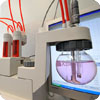M
Publication and design
Publication director: Marc Mortureux
Editor-in-chief: Paul Martin
Assistant managing editor: Barbara Gouget
Editorial board: Maria Laura Boschiroli (France, Anses), Sabine Delannoy (France, Anses), Bertrand Lombard (France, Anses), Stefano Morabito (Italy, ISS), Françoise Petter (OEPP), Elisabeth Repérant (France, Anses), Hélène Gayon(France, SCL), Thierry Van Den Berg (Belgium, Coda Cerva ), Eric Verdon (France, Anses)
Creation/Development: Julien Vigneron, Céline Leterq, Fabrice Coutureau, Parimage
ISSN 2110-5294
Editorial
Point of view
EuroReference No.7, 2012, Biotox Piratox








Modelling Listeria monocytogenes contamination to improve surveillance in the agri-food industry
Natalie Commeau INRA/AgroParisTech, UMR 518 MIA, Paris, France
Agri-food companies are accountable for the quality of the products that they place on the market. One way to check this quality is to determine how contamination is distributed. A sampling plan would be a useful decisionsupport tool. To determine the optimal batch sample size, we used an approach based on Bayesian decision theory for finished food products that minimises the average cost incurred by the manufacturer. Here, we used data on the presence of Listeria monocytogenes during the production of diced bacon. We built models to describe the L. monocytogenes concentration by taking into account various factors, we estimated parameters using Bayesian inference and then compared our models with real data. Finally, we developed a model to determine how to minimize the average costs incurred by a meat-processing company in the case of L. monocytogenes contamination in diced bacon.

In this issue, two articles are devoted to the new French regulations on MTs, microorganisms and toxins which may be used for purposes of bioterrorism or agroterrorism. The first article has been published in the Focus section and presents the general rules and principles for implementing these new regulations in ANSES's laboratories in France; the second article, published in the Methods section, is a practical guide for setting up these new biosafety and security requirements. It is possible, perhaps even probable, that other European countries will adopt similar regulations, and so we felt that these guides might be a way to share experience that may be useful to all.
Also on the topic of new regulations, another article in the Focus section comments on the amendment of Regulation (EC) No. 882/2004 on the organization of official controls in EU Member States.
So alongside articles on methodology and research (screening for neonicotinoids in nectar; modeling Listeria monocytogenes contamination; monophasic Salmonella strains), this issue also focuses extensively on French and European regulatory issues.
And to conclude, the Point of view section provides a discussion of the role of reference laboratories in surveillance, in an article written from a European point of view.
We hope you enjoy reading further.
The Editorial Board
Methodological guide to the assessment of biological safety and security risks
Sébastien Allix, Stéphanie Etienne, Bruno Garin-Bastuji, Benoît Gassilloud, Isabelle Iteman, Véronique Jestin, Florence Lavissière, Nora Madani, Philippe Marianneau, Elodie Monchatre-Leroy, Franca Rizzo, Elodie Rousset, Sylvie Zini; ANSES, Maisons-Alfort, France
> Download the complet methodological guide
Molecular confirmation method for monophasic and non-motile variant strains of Salmonella serovar Typhimurium
R. Lailler (renaud.lailler@anses.fr), J. Grout, M. Marault, C. Oudart, F. Moury, A. Brisabois Université Paris-Est, Bacterial characterisation and epidemiology unit (CEB), Laboratory for Food Safety, ANSES, Maisons-Alfort, France
Salmonella remains the primary cause of confirmed foodborne illness outbreaks in France. Among the 2600 serovars identified in the Salmonella genus, some are isolated more frequently in human health, food hygiene and/or animal health.
Over the past five years, Salmonellae known as “Typhimurium-like variants” have emerged in humans and are foundin many areas of the food chain and livestock sector.
This article presents a molecular characterisation method developed and applied since 2010 for surveillance purposes. The method meets the on-going need to change laboratory analyses to comply with regulatory requirements and to implement control measures for the prevention of the microbiological hazards associated with the possible presence of Salmonellae in food.
Implementation of the new French regulations on microorganisms and toxins: ANSES's experience
S. Allix, B. Garin-Bastuji, V. Jestin, N. Madani, P. Marianneau, E. Monchâtre-Leroy, F. Rizzo, E. Rousset, K. Sidi-Boumedine, S. Zini; ANSES, French Agency for Food, Environmental and Occupational Health & Safety, Maisons-Alfort, France
The new French regulatory measures for operations involving microorganisms and toxins (MTs) are making lasting changes to the sector of microbiology laboratories. This new regulatory framework reinforces the control measures in this area to improve biological safety and security. In practice, it results in increased administrative and operating requirements that call for greater vigilance on the part of operators. To fulfil these new requirements, the French Agency for Food, Environmental and Occupational Health & Safety (ANSES) has implemented an in-house methodology for risk assessment, taking into account the specificities of its reference and research laboratories.
Focus on a laboratory
Revision of regulation (EC) No. 882/2004 on the organisation of official controls
Françoise KREMER SDPRAT- DGAL - French Ministry of Agriculture, Paris, France
The European Commission recently adopted (6 May 2013) a set of four proposed regulations concerning animal health, plant health, plant reproductive material, and official controls1. This last text will replace Regulation (EC) No. 882/2004 on official controls, drawn up as a part of the “Hygiene Package” to cover a broader scope, especially concerning the plant sector. It will provide a basic text governing the organisation and quality of official controls, both as regards production in the various Member States and the importing of products and animals from outside the EU. The next stage is for the European legislative bodies, the Parliament and the Council, to examine the proposals and bring them into law in their final form.





- Home
- N° 12, Summer 2014
- Back issues
- N°11, Winter 2013
- N°10, Summer 2013
- N°9, Spring 2013
- No. 8, Winter 2012
- No. 7, Summer 2012
- No. 6, Winter 2011
- No. 5, Summer 2011
- No. 4, December 2010
No. 3, June 2010
- No. 2, December 2009
- No. 1, June 2009
- Search an article
- Subscribe
- Contributions
Methods
Research
Determination of neonicotinoid residues in nectar by liquid chromatography coupled with tandem mass spectrometry (LC-MS/MS)
Anne-Claire Martel, Patrick Mangoni, Cristina Gastaldi-Thiery ANSES, Sophia-Antipolis Laboratory, France
Nectar is a sweet liquid produced by the nectaries of plants. It is the primary source of energy for bees. Melliferous plants visited by pollinators can contain pesticide residues as the result of plant protection treatment or environmental contamination (soil, water or air). Bees can thus come into contact with these residues via the contaminated nectar that they take back to the colony. The laboratory has therefore developed a method for assaying residues of neonicotinoids in nectar to help establish the implication of these insecticides in cases of the weakening of bee colonies.
Find out the EURL Agenda
EURL on Antimicrobial and Dye Residues in Food
EURL for Milk and Milk Products
EURL for Listeria monocytogenes
EURL for coagulase-positive Staphylococci
EURL for equine diseases
Agenda



